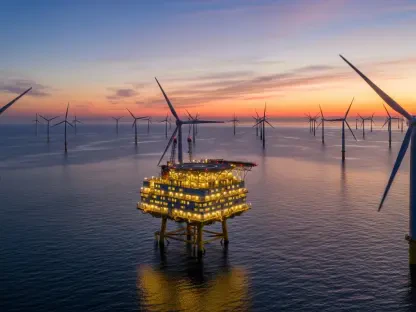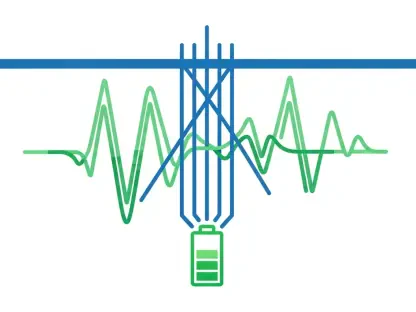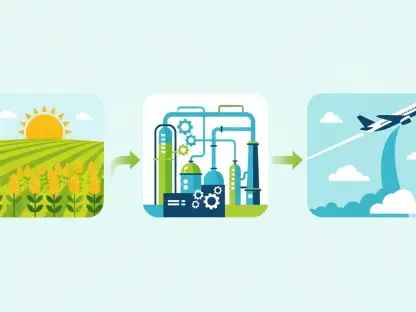The anticipated surge in natural gas demand in the United States is driven by several factors, including increased electricity consumption, exports, manufacturing onshoring, and the electrification of various sectors. This article delves into how the energy sector, particularly ConocoPhillips (NYSE: COP), is strategizing to capitalize on this growing demand. A specific emphasis is placed on the role of artificial intelligence (AI) data centers in potentially boosting natural gas demand further. The discussion extends to compare different strategic approaches within the industry and how these align with broader market expectations both domestically and globally.
ConocoPhillips’ Strategic Positioning
Balancing Domestic and Global Opportunities
ConocoPhillips is carefully navigating the anticipated surge in natural gas demand. The company remains bullish on gas volumes in North America but maintains a conservative outlook on pricing. To maximize the value of its production, ConocoPhillips is prioritizing LNG exports to higher-value international markets. However, it remains open to exploring domestic opportunities, such as supplying gas to AI data centers, provided these projects align with its financial goals and capital competitiveness.
The company’s approach is guided by its desire to balance immediate revenue streams with long-term strategic positioning. ConocoPhillips’ decision to focus on LNG exports illustrates its recognition of higher-value markets abroad, where the demand for clean and reliable energy sources continues to grow. This strategy not only capitalizes on its substantial production capabilities but also diversifies its market reach, which is particularly pertinent given the growing uncertainty in global energy markets. The emphasis on LNG exports allows the company to hedge against unfavorable gas prices domestically and ensure revenue stability through long-term international contracts.
Leveraging LNG for Higher-Value Markets
A key point highlighted by CEO Ryan Lance is ConocoPhillips’ significant presence in the natural gas market, buoyed by its substantial production capabilities and extensive landholdings. Despite its exploration of various domestic opportunities, the company’s conservative pricing outlook for natural gas drives its focus on higher-value markets through LNG. As Lance notes, North American gas volumes are expected to rise, but prices are not as favorable, prompting the company to leverage LNG exports to capitalize on more lucrative international markets.
In this context, ConocoPhillips’ strategic focus on LNG is not merely a response to market conditions but also a proactive measure to enhance its overall market position. By targeting high-value markets, the company aims to maximize the profitability of its natural gas assets, ensuring that its production capabilities are utilized to their fullest extent. The choice to focus on LNG exports underscores a broader industry trend of seeking stability and value in an increasingly volatile global energy landscape. It also reflects a commitment to aligning its operations with global trends, ensuring that ConocoPhillips remains competitive and relevant in the long term.
International Commitments and LNG Infrastructure
Securing Long-Term Agreements
In support of its LNG-centric strategy, ConocoPhillips has made significant strides internationally. Last year, the company secured long-term agreements with the Zeebrugge LNG terminal in Belgium and established LNG sales agreements in Asia. Such commitments exemplify ConocoPhillips’ intent to channel its gas production into higher-value markets through LNG infrastructure, such as the Port Arthur LNG terminal, positioning it advantageously in the global energy landscape.
These international commitments are not just about securing market presence; they are strategic moves to ensure stability and predictability in revenue streams. By locking in long-term agreements, ConocoPhillips mitigates the risks associated with market volatility and price fluctuations. These agreements are also indicative of the company’s proactive stance in aligning its production with global demand trends, ensuring that it remains a key player in the international LNG market. Additionally, investments in LNG infrastructure like the Port Arthur terminal exemplify a forward-thinking approach, enhancing its capacity to serve high-demand markets efficiently.
Expanding Global Footprint
ConocoPhillips’ international commitments reflect a strategic move to diversify its market reach and ensure stable revenue streams. By securing long-term agreements and investing in LNG infrastructure, the company is well-positioned to meet the growing global demand for natural gas. This approach not only mitigates the risks associated with domestic price volatility but also enhances ConocoPhillips’ competitive edge in the international energy market.
Investing in LNG infrastructure also signals ConocoPhillips’ readiness to meet future energy needs sustainably. With the global push towards cleaner energy sources, the company’s LNG-centric strategy positions it as a key player in providing transitional energy solutions. This forward-looking approach is designed to capitalize on the increasing preference for LNG over traditional fossil fuels, providing a cleaner and more efficient energy source for various global markets. ConocoPhillips’ strategic positioning in this context highlights its adaptability and commitment to meeting the evolving needs of the global energy sector.
Domestic Opportunities and AI Data Centers
Exploring Gas Supply for AI Data Centers
ConocoPhillips also explores supplying gas to AI data center operators seeking fast and affordable power. Lance acknowledges the presence of low-cost gas supplies in regions like the Permian Basin and entertains the idea of developing gas-fired power capacity akin to industry peers. However, he questions the scalability of such initiatives, emphasizing the need for alignment with the company’s financial framework and competitive capital allocation.
The prospect of supplying gas to AI data centers presents an intriguing opportunity for ConocoPhillips. These centers, which require substantial energy to operate, represent a significant potential market for natural gas. The company’s vast reserves and production capabilities position it well to meet this demand. However, the emphasis on scalability and financial alignment underscores a cautious approach. ConocoPhillips is keen to ensure that any new ventures are not only viable but also profitable, aligning with its broader strategic and financial goals.
Evaluating Scalability and Financial Alignment
This prudent approach reflects ConocoPhillips’ cautious yet strategic outlook on expanding its domestic footprint in the power generation sector. While the potential for supplying gas to AI data centers is recognized, the company remains focused on ensuring that such projects are scalable and financially viable. This balanced assessment allows ConocoPhillips to explore new opportunities without compromising its core financial objectives.
Evaluating the scalability and financial alignment of supplying gas to AI data centers involves rigorous analysis and strategic foresight. ConocoPhillips is aware of the significant capital investments required for developing gas-fired power generation capacity. As a result, the company is taking a measured approach, assessing each opportunity against its long-term financial goals and market positioning. This strategy ensures that ConocoPhillips remains agile and responsive to new market opportunities while maintaining a strong financial foundation.
Industry Trends and Competitive Landscape
Chevron’s Strategic Moves
The industry is witnessing several significant trends, with major players like Chevron engaging in similar pursuits. Chevron has partnered with investment firm Engine No. 1 and gas turbine leader GE Vernova to develop up to 4 gigawatts of gas-fired power generation capacity for AI data centers by 2027. This collaboration underscores the potential for these projects to scale and incorporate carbon capture and storage to reduce their carbon footprint, demonstrating a convergence of energy production and environmental considerations.
Chevron’s ambitious partnership highlights the growing importance of integrating traditional energy solutions with innovative technologies to meet future demands sustainably. The inclusion of carbon capture and storage in these projects signals a commitment to reducing the environmental impact of gas-fired power generation. This approach not only addresses the increasing need for energy but also aligns with broader environmental objectives, showcasing a balanced and forward-thinking strategy. Chevron’s move also reflects a growing trend among industry giants to harness collaborative efforts to drive innovation and sustainability in the energy sector.
NextEra Energy’s Integration of Renewable Sources
Similarly, NextEra Energy, a leading utility and renewable energy developer, is exploring additional gas-fired power capacity in partnership with GE Vernova. With its established expertise in constructing and operating gas-fired facilities, NextEra Energy aims to integrate renewable energy sources with gas power, positioning itself competitively within the evolving energy market. These strategic moves by industry giants highlight an overarching trend of integrating traditional gas-powered generation with innovative, low-carbon solutions to meet future energy demands sustainably.
NextEra Energy’s approach exemplifies a holistic strategy that leverages its strengths in both gas-fired power and renewable energy. By integrating these two energy sources, the company aims to create a diversified and resilient energy portfolio that can adapt to changing market dynamics and regulatory landscapes. This integration also reflects a broader industry trend towards adopting hybrid energy solutions that maximize efficiency and minimize environmental impact. NextEra’s strategic initiatives signify a forward-looking approach that positions it favorably in the race towards sustainable and reliable energy production.
ConocoPhillips’ Balanced Approach
Hedging Against Domestic Price Volatility
ConocoPhillips’ approach stands out in its balanced assessment of both domestic and global opportunities within the natural gas sector. While the company sees potential in supporting AI data centers domestically, its commitment to the LNG market reflects confidence in deriving maximum value from international market dynamics. This dual focus allows ConocoPhillips to hedge against unfavorable gas prices domestically while capitalizing on robust demand through long-term LNG contracts.
This strategic balance demonstrates ConocoPhillips’ ability to navigate complex market environments effectively. By hedging against domestic price volatility through its LNG exports, the company ensures a stable revenue stream while remaining flexible enough to explore new opportunities within the domestic market. The commitment to LNG exports as a cornerstone of its strategy reflects a clear understanding of market trends and dynamics, ensuring ConocoPhillips remains competitive and resilient in the face of changing global energy landscapes.
Aligning with Industry Trends
The expected rise in natural gas demand in the United States can be attributed to multiple factors, such as higher electricity consumption, increased exports, manufacturing onshoring, and the shift towards electrifying various sectors. This article explores how the energy industry, particularly ConocoPhillips (NYSE: COP), is positioning itself to take advantage of this escalating demand. It highlights the potential boost in natural gas demand from the development of artificial intelligence (AI) data centers. Additionally, the article examines different strategic approaches within the industry and evaluates how these strategies align with wider market forecasts, both nationally and internationally. The importance of adapting to technological advancements and shifting global trends is underlined to ensure that energy companies remain competitive and meet the rising demand efficiently.









